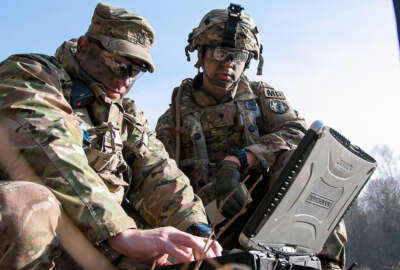
Pentagon on two-year glidepath to ‘fix’ electronic warfare
A cross-functional team is working on specific steps to implement an electromagnetic spectrum operations strategy DoD released in October.
Best listening experience is on Chrome, Firefox or Safari. Subscribe to Federal Drive’s daily audio interviews on Apple Podcasts or PodcastOne.
The Pentagon knows electronic warfare is going to be a big part of any great power competition with China and Russia, but it also knows it’s running a bit behind.
Congress, growing impatient with a problem the department has long acknowledged, gave the Defense Department two years to start to solve it, including by putting a single organization in charge of electromagnetic spectrum operations (EMSO).
After having somewhat neglected electronic warfare during a long focus on low-tech enemies in Iraq and Afghanistan, the military services have actually made some significant gains in developing new capabilities over the past year, according to Gen. John Hyten, the vice chairman of the Joint Chiefs of Staff. But Hyten said the next, bigger challenge will be integrating electromagnetic spectrum operations into joint warfare.
“We’re organizing better, we’re equipping better, we’re training our forces better, but we have a lot of work to do,” he told a forum organized by the Association of Old Crows Wednesday. “If you’re an air component commander, you have to fight and win the spectrum fight, and land component, maritime component, space, and joint force commanders, same thing. And if you try to segment it off to the side, you’ll lose the joint fight. So we have to wrap our arms around the fact that spectrum is kind of the first critical element of being successful in all-domain operations.”
So, before DoD follows through on Congress’s instructions to put a single Defense entity in charge of spectrum operations, it’s first creating what the Pentagon calls a joint warfighting concept for multi-domain operations — with the electromagnetic spectrum as a key component.
“And when you look at that concept, there’s going to be four supporting concepts underneath: joint global fires, Joint All-Domain Command and Control, contested logistics, and information advantage,” Hyten said. “The Joint Requirements Oversight Council, with the agreement of all the service vice chiefs who, with me, make up the JROC, have agreed that we’re going to publish a joint requirement for each one of those supporting concepts, and each of the services will be responsible for meeting those joint requirements.”
As another step to improve its posture in the electronic warfare arena, the department has stood up a cross-functional team, led by Hyten, who is also DoD’s senior designated official (SDO) for electromagnetic spectrum operations.
By this spring, the team is expected to have fully developed an implementation roadmap for the electromagnetic spectrum superiority strategy the department published in October. That strategy laid out five goals:
- Develop new capabilities
- Create an infrastructure to link them together
- Build readiness for those new capabilities
- Improve DoD’s ability to use electronic warfare in concert with allies, and
- Build a governance structure across the military services.
“The cross-functional team is doing amazing work, but I’ll also look everyone in the eye and say, ‘Your job within a couple of years is to be out of business,’” he said. “Two years from now, I want EMSO and electronic warfare fixed across the joint force, fixed in the services, with the right leadership and right authorities in place to do the right thing. Electronic warfare is the job of every commander in the world at every level, and every commander in the world has to embrace it at every level and understand wherever they work, they have to be able to dominate spectrum operations. And once that happens, you don’t actually need an SDO.”
The 2021 National Defense Authorization Act which Congress just passed over President Trump’s objections includes a provision requiring DoD to consolidate its departmentwide electromagnetic spectrum responsibilities into a single organization within the next two years. Those responsibilities include serving as the proponent for electronic warfare capabilities, providing contingency support to combatant commands, and supporting joint training and planning.
It’s not yet clear where those responsibilities will end up, but an earlier, Senate version of the bill suggested they be transferred to the Joint Staff. Right now, many of them are held by U.S. Strategic Command.
But Hyten — who formerly served as STRATCOM’s commander — said that combatant command has never been resourced to properly handle the electronic warfare job.
“The first thing we have to do is make STRATCOM whole in the EW community, because they’re under-resourced, under-manned, and not fully capable of performing the duties they’ve been given by the department,” he said. “Before we transfer a mission from STRATCOM, we need to fix STRATCOM. What we’ve done over the past years is we say, ‘Alright, STRATCOM, you’re now in charge of EMSO, fix the problem,’ but we give them no resources. If we do the same thing, we’ll give it to somebody else in a couple of years, they’ll have no resources and we won’t make the progress that we need to.”
Copyright © 2025 Federal News Network. All rights reserved. This website is not intended for users located within the European Economic Area.
Jared Serbu is deputy editor of Federal News Network and reports on the Defense Department’s contracting, legislative, workforce and IT issues.
Follow @jserbuWFED
Related Stories






